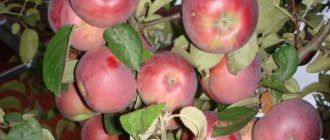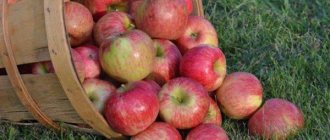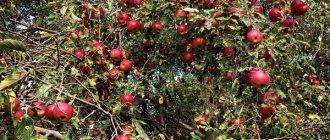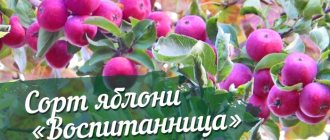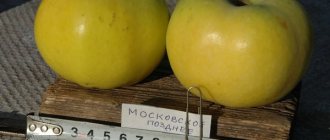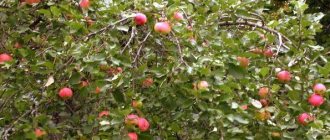The apple tree “Streifling” (“Strifel”) is of Baltic origin, but most domestic summer residents are very familiar with it under the name “Autumn Striped”. This ancient variety of folk selection originally appeared presumably in Holland back in the 18th century, but to this day remains one of the most beloved and widespread in central Russia, Belarus and, naturally, in the Baltic countries.
"Streifling" (pictured) is rightfully considered the standard of autumn apples
If you are interested in what the features of the variety are, we suggest starting by considering its main characteristics in the table:
| Parameter | Characteristic |
| Culture | Apple tree (Malus domestica Borkh.) |
| Variety | “Autumn Striped” (Shtreifling, Striefel), popular names: Autumn Striped, Strifel, Livlyandskoe, Amtmanskoe, Obrezkovoe, Starostino |
| Tree height | Tall – up to 8-10 m |
| Precociousness | Relatively low - in the 8-9th year after planting |
| Terms of removable (technical) maturity | Third ten days of August – early September |
| Period of consumption/shelf life of fruits | Autumn (late autumn) – apples are stored until December |
| Type of fruiting | Mixed - on ringlets and fruit twigs |
| Productivity per tree | Very high – more than 200 kg |
| Fruit weight | On average 80-100 g (under favorable conditions 140-150 g) |
| Shape and color | The fruits are truncated or round-conical in shape, often unequal, with pronounced ribs at the base. The skin is thin, smooth, covered with a waxy coating. The main color is greenish-yellow (when picked) and yellow (when reaching full maturity). The integumentary layer - in the form of bright orange-red stripes on a speckled background, is present on most of the surface of the fruit, and becomes brownish when ripe. Red fruit mutations have apples that are a solid dark red color. |
| Fruit pulp | Light, yellowish, sometimes with a pink tint under the skin, loose, quite juicy |
| Tasting assessment (taste qualities) | 4.5 points (out of 5) – sweet and sour taste, harmonious |
| Purpose of fruits | Dessert (universal - suitable for various processing methods) |
| Sustainability | Frost-resistant, weakly resistant to drought, moderately affected by fruit and leaf scab |
| Year of inclusion in the State Register of the Russian Federation | 1947 |
| Recommended growing regions | Northern, Northwestern, Central, Volga-Vyatka, Central Black Earth, Middle Volga |
| Originators | OJSC Agro-Industrial Society "Taitsy" (Leningrad region), Federal State Budgetary Institution "Federal Agrarian Scientific Center of the North-East named after N.V. Rudnitsky" (Kirov) |
Registration and zoning of a variety
“Autumn Striped” was officially included in the State Registers of the Russian Federation (1947) and Belarus (1954) as a variety recommended for cultivation in regions with rather harsh climatic conditions. In terms of winter hardiness, this apple tree is inferior only to “Antonovka vulgaris”, “Cinnamon striped” and “Moscow pear”, but is superior to many popular varieties of the crop, for example “Welsey” and “Pepin saffron”. Over the years of observations (back in the middle of the last century), only slight freezing of fruits and 3-4-year-old shoots was observed on the trees; flower buds were practically not damaged.
Scab-affected apple fruits and leaves
The variety does not have immunity to scab; resistance to fungal diseases is assessed as average or above average.
VNIISPK specialists use “Osenneye Polosatoe” as a control sample when testing new varieties of their own selection to compare and determine the degree of their winter hardiness and susceptibility to scab.
“Streifling” is sensitive to drought: the tree reacts to a lack of moisture (especially in the second half of summer) by prematurely dropping leaves and shrinking fruits.
Pest control and disease prevention
Apple trees are subject to invasion by aphids, weevils, codling moths, flower beetles, scale insects, moths, and mites. Most often, old trees with bark damage and untreated diseases are affected. The spread of pests is facilitated by thickets of weeds in the garden.
To protect the garden from pests, the crown is sprayed and sticky trapping belts are installed on the trunks. The belts reliably protect the plant from ants that carry aphids from tree to tree.
Against flying insects, apple trees are treated with: Inta Vir, Permethrin, Deltamethrin. Treatment is carried out 2 times per summer, at the beginning of the season and in the middle (or at the end of summer for young trees). These drugs must not be used later than 2 weeks before harvest.
More gentle pest control measures that do not negatively affect the harvest: an aqueous solution of fir, garlic, mint oils. By installing feeders with bird food, sparrows, jays, thrushes and other birds - natural enemies of insects - are attracted to the garden.
Autumn striped apple trees can suffer from viral and some fungal diseases. Proper agricultural technology, together with preventive treatments, will protect the garden from infection.
Starting from bud break, the trees are sprayed with the following preparations: HOM, Abiga Peak, Bordeaux mixture 1%. Treatments are carried out 3 times during the summer: in spring, before flowering and after leaf fall.
It is important to remove all fallen leaves and carrion apples in the fall so that plant debris does not become a wintering haven for pests and fungal spores.
Dimensions of the plant and characteristics of fruiting
This apple tree is distinguished by its impressive size - mature trees can grow up to 8-10 m in height and have a crown of approximately the same diameter. The wide, spreading crown, shaped like a cauldron, consists of powerful branches with drooping ends and is prone to thickening due to the intensive annual growth of new shoots.
When caring for an apple tree, experienced gardeners consider it necessary to carry out spring pruning every year.
The shoots are thick; the bark on them is smooth, slightly shiny, pubescent, brown-chestnut in color with light yellow, elongated or rounded, clearly visible lenticels. Large buds are gray, very convex, wide. The leaves are grayish-green, round, wrinkled, heavily pubescent (felt), with a corkscrew twisted apex and jagged (large-crowned) edges. The leaf blade is folded “boat” along the central vein. The foliage densely covers the shoots, especially in their upper part, forming lush “caps”. The petioles are short and thick with a reddish (anthocyanin) color. The buds are light pink, the flowers are large, saucer-shaped, with white, round, concave petals, overlapping each other. The pistil has a fused column, its stigmas are located at the level of the anthers or slightly higher.
The type of fruiting is mixed: the ovaries are formed on short ringlets located on 3-4-year-old branches, as well as on the ends of long fruit twigs (2-year-old).
Abundant flowering usually occurs in mid-May.
When planting a “Streifling” apple tree, it is important to take into account that it is not self-fertile and for full pollination there must be trees of other varieties nearby that bloom at the same time, for example “Antonovka”, “Welsey”, “Slavyanka”, “Papirovka” and others .
Professional fruit growers recommend placing at least 3 apple trees of suitable pollinating varieties in joint plantings for every 10 “Autumn Striped” seedlings.
You should not expect a quick harvest from a young tree; it begins to bear fruit in the 5-6th year, and the number of apples is insignificant. But, starting from 9-10 years of age, one tree can produce more than 200 kg per season (a record figure of 429 kg!) annually . Mature apple trees over 18-20 years old bear fruit periodically (not sharply) and delight with their high yields every two years.
In adult apple trees, productivity indicators are unstable - after the harvest season, the next year the tree can “rest” and produce significantly less fruit
In central Russia, the main harvest of “Autumn Striped” is harvested in the third ten days of August – early September.
How the Striefel apple variety is grown
Among other varieties of apple trees, Autumn Striped is distinguished by its unpretentiousness. But to obtain a stable harvest of healthy, clean apples, it is necessary to adhere to the rules of agricultural technology.
Accommodation in the garden
Apple trees on their own roots (not grafted) are planted at an impressive distance from each other, keeping in mind the size of an adult tree. The diameter of the Striefel crown reaches 8 m; its density does not allow planting shrubs and vegetables in the root zone of the tree. The optimal distance between Autumn striped seedlings is 9-12 m.
In the garden where the Striefel tree is planted, it is recommended to place 2-3 seedlings of other varieties of apple trees to obtain cross-pollination.
Modern gardeners are increasingly refusing to plant vigorous rooted apple trees due to saving plot space. Cuttings of varietal plants are grafted onto semi-dwarf and dwarf rootstocks, which can be planted at a distance of 1.5-2.5 m from each other. The height of such trees is limited to 3 m. Semi-dwarfs are characterized by early fruiting - in the 4th year, versus 8 years of waiting for a harvest for a vigorous tree. As a result, the low (no more than 20 kg) yield from one tree is compensated by an increase in the overall yield per plot area and early fruiting.
For Autumn Striped, the following rootstocks are used: Red-leaved Paradise (for the southern regions), M9, MM106, M4 (for the middle zone).
Planting seedlings
Traditionally, planting an apple orchard begins in spring or autumn, although summer planting is also acceptable. The exact choice of planting time depends on the climate of the area where the site is located.
Spring planting of a garden is practiced in the northern regions, where autumn is short and rainy. A seedling placed in the ground at the end of August - September may not have time to take root before the cold weather arrives and will die.
In the southern regions, on the contrary, autumn planting is welcomed. By September, the summer heat subsides, it rains, and until November the weather is comfortable for plants.
In summer you can plant apple trees growing in a container. The seedling will successfully take root, provided that the trees are shaded from the scorching sun, the crown is watered and sprayed with water.
Striefel apple trees grafted onto dwarf and semi-dwarf rootstocks are recommended to be planted in spring and the first half of summer.
Preparing soil and planting holes
Apple trees of the Autumn Striped variety do not have strict requirements for soil quality. Particular attention is paid only to the depth of underground water. If the seedling is self-rooted (vigorous), then it is planted in an area with a groundwater level of 2.5 m and below. For grafted dwarf plants, water at a depth of 70-80 cm is acceptable.
Experienced gardeners recommend starting digging a planting hole a month to a month and a half before planting. Its size depends on the size of the root system of the seedling + 30 cm. The approximate size of the holes is 50 (width) by 70 cm (depth).
The following are laid in layers at the bottom of the pit:
- drainage from broken brick, crushed stone or expanded clay - 25 cm;
- a mixture of humus (vermicompost), forest soil, 60 g of superphosphate, 2 cups of wood ash - 2 buckets.
Separately, clean fertile soil is poured near the hole to cover the roots of the plant.
Planting a Striefel apple tree seedling step by step with photos:
- Before planting, it is recommended to soak the roots of the apple tree in a disinfectant solution. To destroy the infection, potassium permanganate, Fitosporin, and Maxim are added to the water. The seedling is kept in the solution for 30-40 minutes.
- The seedling is lowered into the center of the hole and placed on the fertile mixture poured earlier. The roots are straightened, making sure that their tips do not bend upward.
- The roots of the Autumn Striped apple tree are covered with soil, leaving the graft on the surface. The soil is pressed tightly against the roots, carefully trampling with your feet.
- An earthen roller 15 cm high is poured around the planting hole. It will prevent the spreading of irrigation water.
To ensure that the young tree grows evenly and does not break from gusts of wind, at the same time as the seedling is immersed in the hole, a strong stake is driven into it. The trunk of the seedling is loosely tied to the support with a soft tape.
Caring for the Striefel apple tree from the moment the seedling is planted
After planting the seedling, it must be watered abundantly. Use at least 2 buckets of non-chlorinated water. The soil is re-moistened as it dries. To prevent the formation of a crust on the surface of the earth, the soil must be loosened to a depth of 3-5 cm.
Most gardeners use mulching around the tree trunks and turfing the rows in the apple orchard.
Mulching the tree trunk circle with straw or hay, chopped tree bark, and large shavings allows the soil under the shelter to retain moisture longer after watering. Under the shelter, earthworms actively reproduce, and weeds do not sprout. The thickness of the mulch layer should be at least 15 cm.
Mulching seedlings during autumn planting allows young plants to overwinter more successfully.
Turfing is the sowing of lawn or field grasses in order to crowd out weeds and maintain soil moisture. White clover, bentgrass, fescue, mint and other fast-growing herbs are sown in the orchard. Their roots form a surface turf, preventing weeds from growing. The greens are periodically mowed, leaving it as mulch.
Before the start of winter, the trunks and skeletal branches of the Striefel apple tree are covered with whitewash. It is necessary to protect the tree bark from sunburn and frost damage.
To prevent the whitewash from being washed away by rain, PVA glue is added to the lime paste. In February - March, the whitewash can be renewed.
If there are a lot of rodents on the site, you can protect the young garden from mice using plastic bottles. The bottle is cut so that an even cylinder remains. Having cut the plastic lengthwise, the cylinder is put on the barrel and secured with a rope. The trunk should be protected above the snow cover.
In spring, young seedlings are inspected for damage. If there are cracks, ulcers and wounds on the bark, they are cleaned back to healthy wood. The wound is covered with garden varnish based on oleoresin resin. Instead of pitch, you can use a mixture of clay and mullein; the “compress” is secured to the trunk using strips of cotton fabric.
Feeding
The Striefel apple variety needs two feedings per season, starting from the second year of cultivation:
- In the spring, in April - early May, the tree is fed with nitrogen fertilizer. Nitrogen is necessary for the growth of young shoots and greenery. Use an aqueous solution of urea (50 g per 10 l of water) or nitroammophosphate (40 g per 10 l). 20 liters of nutrient solution is enough for a young seedling; a fruit-bearing tree needs from 3 to 6 buckets of dissolved fertilizer. You can, immediately after the snow melts, mulch the tree trunk with rotted manure (horse or mullein), using 3-4 buckets. With rain and irrigation water, nutrients will gradually go into the soil, feeding the roots.
- In September it is time for the garden to prepare for winter. The trees are fed with phosphorus-potassium fertilizers, which promote the ripening of the wood and root system. Use superphosphate 50 g per 10 liters and potassium sulfate 30 g per bucket of water. The volumes of fertilizing are the same as for spring application.
When feeding an adult tree, it is convenient to pour the nutrient solution into pre-drilled holes around the circumference of the crown. Their depth is 20-30 cm, diameter 3-5 cm.
How the Striefel apple variety is pruned
The Autumn Striped apple tree, like no other variety, needs regular formative pruning. The tree begins to form already 2 years after planting. If the seedling is rooted, its crown is made cup-shaped or spherical. If the variety is grafted onto a dwarf rootstock, the crown of the apple tree is given the shape of a column.
In addition to formative pruning, there is also sanitary pruning. Every spring, diseased, damaged and weak shoots are removed from the tree.
Spring pruning of the Striefel apple tree is carried out in March, before the sap begins to flow. In autumn, the tree is pruned in October.
Fruit characteristics
The apples are quite large (depending on weather and climatic conditions, their weight can range from 60-80 to 120-150 g), round or truncated conical in shape, with pronounced ribbing at the base and a smooth surface. The skin is thin, covered with a waxy coating. The main color at the stage of technical ripeness at the time of harvesting is greenish-yellow, and upon ripening it becomes yellow. Most of the surface is covered with bright orange-red stripes against a mottled blush background. In red-fruited varieties (cloned mutations) of the variety, the fruit is a solid dark red color. Subcutaneous dots are light, small, and clearly visible. The saucer is ribbed and narrow. The calyx is large, closed or semi-open, irregular in shape. The funnel is very small, with slight rustiness. Seed chambers are semi-open; the seeds are large and brown.
When fully ripe, the orange-red outer color acquires a brownish tint.
The pulp is light, with a slight yellowish tint, sometimes pinkish under the skin, loose, juicy, aromatic. According to biochemical studies conducted by VNIISPK specialists, it contains:
| Nutrients and beneficial substances | Quantity per 100 g of product |
| Vitamin C (ascorbic acid) | 8.3 mg |
| Sahara | 10.1 g |
| Acids | 0.57 g |
| P-active substances (total) | 280 mg |
| Pectins | 12.0 g |
The taste of the fruit is harmonious, sweet and sour, according to professional tasting assessments 4.5 points (out of 5). Apples are intended to be eaten fresh; if properly stored, they retain their marketability and taste throughout the fall, until the beginning of December. They are also used for processing, primarily for the production of juices.
Harvest and storage
To successfully preserve large volumes of the harvest, harvesting must begin around the beginning of September, when the fruits have a greenish tint. To maximize shelf life, apples should be picked by hand, without using special equipment and trying to preserve the stems.
It is good to use the following as storage containers:
- wooden boxes;
- lattice plastic containers;
- well ventilated cardboard boxes.
Regardless of the type of container, it is recommended to wrap each apple tightly in paper. The fruits should be laid in an even layer, placing a layer of paper between each subsequent row. The optimal microclimate for storing apples will be: temperature from +2 to +5 ° C and good ventilation. An excellent place to maintain the necessary conditions is a cellar, pantry or balcony. In this way, fruits are stored well for 2-3 months.
Since Streifling apples are a table variety, their shelf life is not very long. By the end of December, they begin to gradually wither and lose their juiciness and bright taste. Therefore, before the expiration of the shelf life, they try to sell or process them.
To prevent stored apples from rotting, you must follow some recommendations:
- You can only store fruits taken from the tree in an unripe form;
- apples with mechanical damage cannot be stored;
- Fruits with stalks are stored better;
- You should not wipe off the natural waxy coating from apples;
- for uniform ripening, fruits of the same size are laid out in boxes;
- During storage, it is necessary to inspect fruits more often for rotting apples.
Advantages and disadvantages
The long-term popularity of the variety is explained by the large quantities and high quality of apples - tasty and aromatic. In addition, “Autumn Striped” trees are distinguished by their durability and winter hardiness.
With large harvests, a significant part of the apples have to be processed, since they are not intended for long-term storage
Among the disadvantages, gardeners note a relatively low precocity, the huge size of adult apple trees and their alternation of fruitful and lean years, relative resistance to scab, and rather poor tolerance to drought. To obtain stable yields, the tree requires constant care - annual pruning and treatment against fungal diseases and pests, timely abundant watering and regular fertilizing with fertilizers.
A specialist agronomist talks about pruning and the ability of Streifling to recover in the video:
Apple tree Streifling: care
To obtain a tasty, abundant and high-quality harvest, as well as for the tree to remain healthy, it is necessary to provide it with proper and timely care.
Watering
As mentioned above, this fruit tree is quite demanding on the watering procedure in order to produce larger fruits. Watering should be carried out:
- — For the first time during the period of planting a seedling.
- - After this, during the flowering period, in the month of May.
- — The next watering is done during the period of fruit ripening, in the last ten days of June.
- - Next, before wintering - the second ten days of October.
At a young age, the plant should be watered in the amount of five buckets, and this procedure should be completed with settled water. In adulthood, when the tree is actively bearing fruit, you should spend about 10 buckets of water. With proper watering, the soil layer should be moistened to a depth of about 80 centimeters. This is definitely required for such a powerful rhizome of this fruit tree. It is worth saying that watering quite often, but with a small amount of water is not only useless, but, on the contrary, can cause harm to the plant bark.
Trimming
Due to the fact that the crown of this fruit tree is spreading, a timely pruning procedure for it is considered a mandatory measure. In spring, dried and old stems should be removed. In the autumn, you need to remove all branches with signs of damage or disease infection. Timely pruning helps young shoots to develop well.
Top dressing
This variety of apple crop requires feeding three times in one season. This:
- — In the month of May, before the beginning of the flowering period, or during the blooming of buds. At this time, a urea solution is added (half a glass of the drug per bucket of water).
- - First ten days of June. Fertilizing is carried out with a solution of copper sulfate (2 grams of substance per bucket of water) and boric acid (0.5 grams of substance per bucket of water).
- — In the last ten days of August, before the upcoming winter, the tree is fed with complex mineral fertilizers.
It would be a good idea to also feed the plant in the month of July, in the circle around the trunk. Green manure is used as top dressing, after which the green mass is dug up after a month and a half, as added organic matter.
Reviews from gardeners
Sergey, 42 years old, Novoaleksandrovsk
Our Autumn Striped apples are colored differently in different years, sometimes more intensely, sometimes less brightly. They usually ripen around the 20th of August. Last season, almost all of them were large, beautiful, juicy and tasty. This year the harvest is very large, it’s time to pick, but the apples are somehow faded, the stripes are almost invisible.
Ignat, 54 years old, Minsk
Streifling (Gramstei in our language) has been growing here for a long time. This apple is quite early and less perishable. If you don’t remove them in time, then by the end of August – beginning of September everyone will end up on the ground and will be completely soft. We like them for their pleasant acidity, rich color with pretty veins and loose, crumbly flesh that is easy to bite. They make delicious jam and excellent juice.
Galina, 38 years old, Moscow region
We inherited the Striefel apple tree from our grandfather. She's probably 80 years old already. The tree is huge, it doesn’t bear fruit every year now, but the harvest yields a lot of apples. We try to thin out the crown every spring, spray it against diseases and pests, and be sure to water it during drought, otherwise the fruits will not gain good size and juiciness. However, they cannot be stored for a long time; they have to be processed and distributed to all neighbors.
Features of transplantation
The apple tree crop of this subspecies can be transplanted to another place of growth until the 20th age, since after this age the tree’s ability to adapt and take root in a new place sharply decreases. The best period for replanting is the time after leaf fall, that is, the middle of the autumn period. This plant should not be replanted at the time of active growth of foliage, abundant flowering in May and during the period of fruit ripening.
In early spring, replanting is allowed if cold weather sets in quite early in the autumn. During the summer period, this plant should not be replanted, only if absolutely necessary. This fruit tree should be transplanted into a place with a previously prepared, fertile layer of soil, after digging a hole approximately 30 days before transplantation, so that groundwater can drain. The hole is prepared approximately 7 days before planting in this way:
- — The hole should have the following dimensions: exceed the size of the rhizome by no less than one and a half times.
- — Crushed stone or broken brick is poured at the bottom of the hole.
- — After this, a layer of humus or compost mixed with soil is laid.
- — Superphosphate and wood ash are added.
- — The hole is moistened generously and left alone for about a week.
The Streifling apple tree is replanted in the same orientation to the cardinal points as it grew before. It is required to replant with a lump of soil in which it grew up to this point. The technology for this planting is completely identical to that for planting a seedling. It is very important to correctly calculate the size of the rhizome for digging out a lump of soil. Alone, it will be possible to transplant a tree that is 2-3 years old, since the rhizome of a plant that is five years old will have a diameter of more than one meter.
Apple tree Striefel: description, photo, appearance
Apple tree Striefel: description, photo
This variety is listed in the State Register of Russia, its official name is Autumn Striped, but most often gardeners call it Striefel. This variety has been on the official market for quite a long time, so it has various nicknames, it can be called Livlyandsky, Obrezkov, etc. This variety originated thanks to folk selection, so scientists were unable to determine from which varieties. There is an opinion that Dutch and German varieties were used, which were crossed and a new variety was obtained. The first appearance of the variety dates back to the beginning of the 19th century, it was during this period that it began to spread in the south of Russia.
Despite its age, the variety is still popular due to its positive properties and criteria that suit a larger percentage of gardeners.
The State Register recommends planting in the European parts of Russia, since it is in these territories that the variety grows better and produces a larger and higher-quality harvest.
Striefel has a peculiarity, it lies in the height of the tree. It can reach up to 8-9 meters in height, and the tree also has a wide trunk. The apple tree has a dense crown, since the branches are located very close, it is necessary to carry out regular pruning, which will help the tree function much better. In order for the tree to take up a little less space, it is recommended to carry out formative pruning, during which the tree is shortened by 2-3 meters.
The foliage of the tree is large, with very prominent thick veins that are located on the surface of the entire leaf. Because of this, the sheet curls a little. The surface of the leaves is wrinkled, crumpled, hairiness is observed on one side, and the other side is smooth, glossy, with shine. The foliage is located at right angles to the shoot. Every year the leaves become a little bare at the base.
Landing
The life of a plant depends on many criteria: the planting hole, fertilizers, adherence to planting rules, timing, and the quality of the planting material itself.
It is advisable to plant a young apple tree in the spring so that it adapts to a new place. In autumn, a sharp cold snap can simply kill the plant, but if there is no choice, then it is better to plant it in early autumn. In the southern regions you can do this until winter. The variety feels best in moist and well-warmed fertile soils.
As for the planting rules, in general they are similar to those relevant for other apple trees. A week before the procedure, a hole is formed with a diameter of 1 meter and a depth of 60 centimeters. The infertile lower layer is placed on one edge, the nutritious upper layer on the other.
The loosened soil at the bottom should cover it by 30 centimeters. First, the hole is filled by a third with the top removed layer of soil, and then the following components are added: 10 tablespoons of wood ash, 4 tablespoons of potassium sulfate, a glass of superphosphate, 3 buckets of rotted manure.
Using a shovel, you need to loosen the removed soil, mixing it with fertilizers, and then you need to add the remaining top layer to the middle of the planting hole. The plant is placed in the center, first driving a stake nearby to which the seedling needs to be tied. Fill the hole so that there is a hill 15 centimeters high above it.
Preparing for winter
The variety has a high resistance to frost, but before the onset of the winter period it is recommended to play it safe and provide shelter. It must be carried out for young apple trees, since their resistance to frost is weak and they are just beginning to develop. To prepare the tree, it is necessary to carry out sanitary pruning and apply fertilizer to the tree trunk. Then you need to mulch with peat. The trunk must be whitened, since whitening protects the tree from rodents. Whitewash can be purchased at a specialized store or prepared independently; it will require 5 liters of water and 1.5 kilograms of lime, 500 grams of clay, glue and 5-10 grams of copper sulfate.
Rootstock and subspecies options
Although it is not recommended to graft apple trees onto Streifling itself, it is very often grown on various rootstocks and in several varieties.
Apple trees with dwarf rootstock.
Dwarf
Streifling can be grown on a dwarf rootstock and is very practical. Then the crown does not stretch upward, but grows horizontally, which does not affect the number of fruits, but makes the tree more convenient to use. This subspecies begins to bear fruit earlier. But it is worth considering that the roots of dwarf apple trees are located close to the surface, so they will need to be additionally covered for the winter.
Semi-dwarf
This size apple tree is of medium height, growing up to 2.5 meters. The branches of a young tree grow upward, but with age they droop, making the crown look like an umbrella. Apples are very juicy when grown this way, and they are harvested earlier than on regular trees.
Columnar
No matter how common columnar varieties are, Streifling is not yet grown in such a compact form.
Autumn
We are talking about the Autumn Striped variety, which is a subspecies of Streifling. The apple tree is the same size, but produces smaller fruit. The fruits are stored less and periodically suffer from scab.
Early
The Liflyandskoe variety is an earlier subspecies of Streifling. A smaller tree with a drooping crown. Apple trees ripen earlier and are even considered summer trees. But they are a little sour, although they are larger in size.
Streifling red
The structure of the tree is completely identical to an ordinary apple tree. But the only exception is the shade of the fruit. It is the same striped, but with bright red streaks.
